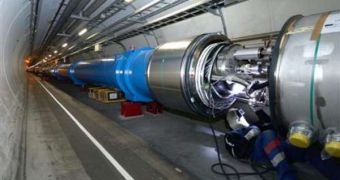According to CERN, the operator of the Large Hadron Collider (LHC), engineers have recently been able to successfully inject particle beams inside sections of the amazingly large particle accelerator. The world's largest physics experiment was shut down in September 2008, after a leak compromised a section of the 27-kilometer tunnel that made up the facility. The LHC is located on the Swiss-French border and is a collaboration between a large number of countries, the BBC News reports.
An LHC spokesperson revealed that engineers working inside the LHC considered the recent achievement a milestone in their strife to bring the particle accelerator back online. The facility is divided into eight sectors, each of them about 3.5 kilometers, and cooled down to a temperature that is lower than that of outer space. The liquid helium inside the magnets keeps the machine at a chilling 1.9 Kelvin (-271 degrees C; -456 degrees F). When a magnet section broke last year, more than a tonne of helium leaked into the tunnels.
In the new experiments, beams of protons were successfully injected inside two sections of the particle accelerator and were then guided both clockwise and counterclockwise. The tests took place between October 23-25, and featured beams of protons and of lead ions. The reason why these particles need to circulate at such low temperatures is the fact that, under specific conditions, magnets become superconducting, which means that they conduct electricity with zero resistance, and lose very little of it at the same time.
“This is a work of synchronization. The fast magnets must be synchronized to accelerate the beam and transfer it from one accelerator to the next and eventually to the LHC, which must be synchronized to accept it. This whole process happens within a few hundred picoseconds – one picosecond is a millionth of a millionth of a second. The aim once the beam is circulating is to accelerate [the beam] up to 3.5 [trillion electron volts]. But that will be in stages. We will first go to one, then 3.5... then from 2011 we're going to try to go to seven,” LHC Deputy Head of Hardware Commissioning Gianluigi Arduini says. The current beams were injected at an energy level of just 450 billion electron volts.

 14 DAY TRIAL //
14 DAY TRIAL //